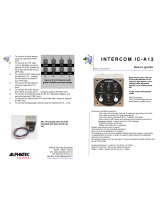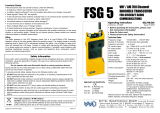
2 VHF Transceiver 620X 0638.420-071 Issue 04 12/2016
Table of Contents
1. Introduction ................................................................................................. 4
1.1. General Safety Definitions ............................................................................ 4
1.2. Packaging, Transport, Storage ..................................................................... 4
1.3. Disposal ........................................................................................................ 5
1.4. Warranty Conditions ..................................................................................... 5
1.5. Conditions of Utilization ................................................................................ 6
1.5.1. Purpose of Equipment .................................................................... 6
1.5.2. Additional Conditions of Utilization .................................................. 6
1.6.
Non Warranty Clause ................................................................................... 6
2. Operating Instructions ............................................................................... 7
2.1. Device Description ........................................................................................ 7
2.1.1. Device Assignment ......................................................................... 8
2.1.2. Scope of Delivery ............................................................................ 8
2.1.3. Additional Required Equipment ....................................................... 8
2.1.4. Type Plate ....................................................................................... 9
2.1.5. Safety-Conscious Utilization ......................................................... 10
2.2.
Controls and Indicators ............................................................................... 11
2.3. Start-Up ...................................................................................................... 13
2.4. Receive and Transmit Mode ....................................................................... 13
2.4.1. Receive Mode ............................................................................... 13
2.4.2. Transmit Mode .............................................................................. 14
2.5.
Frequency Selection Modes ....................................................................... 15
2.5.1. Standard Mode ............................................................................. 16
2.5.2. Direct Tune Mode ......................................................................... 17
2.5.3. Channel Mode ............................................................................... 18
2.5.3.1. Select Channels ......................................................................... 19
2.5.3.2.
Frequency Storage Functions .................................................... 20
2.5.3.3. Store .......................................................................................... 20
2.5.3.4. Automatic Storage Function ....................................................... 22
2.5.3.5. Delete data: ................................................................................ 22
2.5.4. SCAN Mode .................................................................................. 23
2.6.
SQUELCH .................................................................................................. 24
2.7. RX Field Strength Indication ....................................................................... 24
2.8. Channel Spacing Mode .............................................................................. 25
2.9. Auxiliary Audio Input (AUX) ........................................................................ 25
2.10. Intercom Operation ..................................................................................... 26
2.11. VOX & Speaker Operation .......................................................................... 27
2.12. Menus ......................................................................................................... 28
2.12.1. Intercom Menu .............................................................................. 28
2.12.2. User Menu .................................................................................... 30
2.13.
Warning and Failure Indications ................................................................. 32
3. Technical Data .......................................................................................... 34
4. Index .......................................................................................................... 36
























